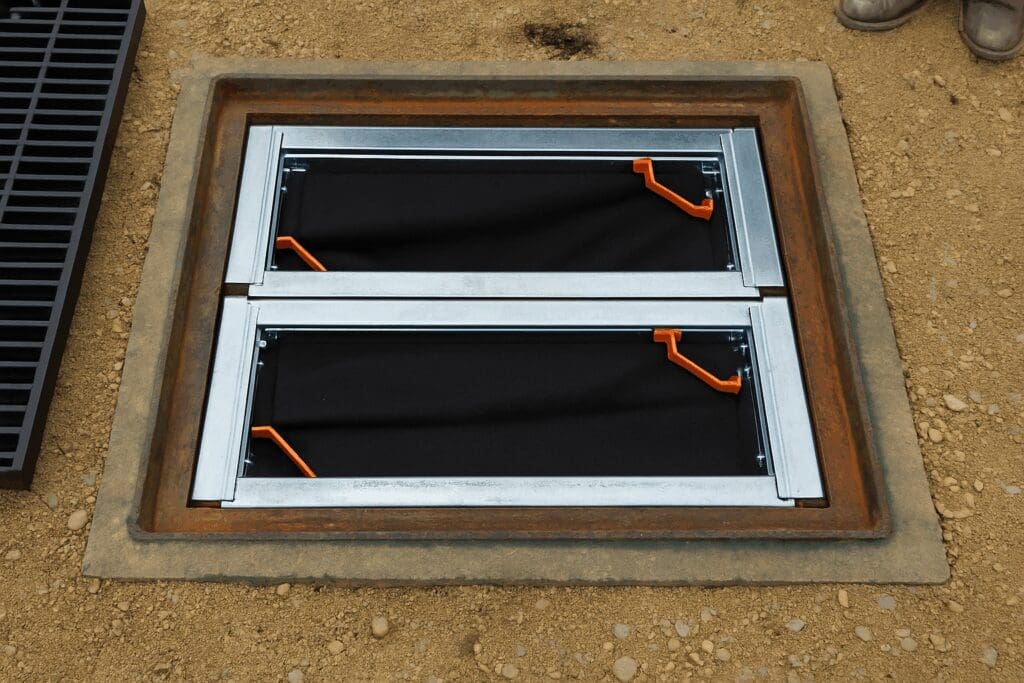As cities grow and pavement replaces green space, managing rainwater has become one of the biggest challenges in urban planning.
Stormwater doesn’t soak into the ground like in natural environments—instead, it rushes over streets, sidewalks, and rooftops, picking up everything from oil and litter to heavy metals and chemicals. Without proper control, this runoff can flood neighborhoods, damage infrastructure, and pollute rivers and lakes.
That’s where stormwater drain filters come in. In this blog, we’ll explore why they matter, how they fit into modern city planning, and their role in building more resilient and sustainable urban environments.
Keep reading to learn more.
What are stormwater drain filters?
Stormwater drain filters are specialized devices installed in or around storm drain inlets to capture pollutants before they enter the drainage system. These filters act as the first line of defense in urban stormwater management, targeting common runoff contaminants like trash, sediment, oil, grease, and heavy metals.
Most stormwater runoff in cities flows directly into local waterways without treatment. That’s why filtration at the source is critical. These filters trap visible debris and finer particles that would otherwise clog infrastructure or pollute streams, rivers, and lakes.
There are several types of filters, each suited to different site conditions:
- Catch basin inserts: Simple mesh or basket systems that fit inside storm drains.
- Filter socks and booms: Flexible tubes filled with absorbent material placed around inlets.
- Geotextile fabrics: Permeable materials that slow runoff and capture sediment.
- Cartridge filters: More advanced systems that remove targeted pollutants with replaceable media.
By physically removing pollutants during rain events, these filters play a vital role in improving water quality, reducing maintenance needs, and supporting sustainable urban planning. When used properly and maintained regularly, they’re a practical, scalable solution for modern stormwater compliance.
Why urban runoff is a growing concern
Urban runoff has become one of the most serious threats to water quality in developed areas.
As cities grow, natural landscapes are replaced with hard, impervious surfaces like roads, rooftops, parking lots, and sidewalks. These surfaces don’t absorb rainwater — instead, they speed it up and push it across the surface, carrying pollutants straight into storm drains.
The result?
A surge of untreated stormwater enters local waterways during and after every rainstorm.
This runoff often contains:
- Oil and grease from vehicles
- Heavy metals from rooftops and brake dust
- Fertilizers and pesticides from landscaped areas
- Litter and microplastics from sidewalks and gutters
- Bacteria from pet waste and leaking sewer lines
Without controls like stormwater drain filters, these pollutants flow freely into rivers, lakes, and coastal zones, harming fish habitats, contaminating drinking water sources, and making recreational water unsafe for people.
In dense urban settings, runoff’s sheer volume and speed may also lead to localized flooding, overwhelmed storm systems, and accelerated erosion.
That’s why modern urban planning must prioritize stormwater filtration and control. It’s about more than managing water — it’s about protecting public health, local ecosystems, and the long-term sustainability of urban environments.

Role of stormwater drain filters in pollution control
Stormwater drain filters serve as critical frontline tools in stopping pollution before it enters stormwater infrastructure. Their job is simple but essential: capture and contain contaminants that rainwater picks up as it runs over streets, parking lots, construction sites, and other urban surfaces.
These filters help control a wide variety of pollutants, including:
- Trash and debris: plastic wrappers, cigarette butts, and food waste
- Sediment: soil, sand, and fine particles from erosion or construction
- Hydrocarbons: oil, grease, and other petroleum products from roads and vehicles
- Heavy metals and nutrients: zinc, copper, phosphates, and nitrates
By filtering out pollutants before they enter storm drains, these systems directly improve the quality of runoff and protect receiving waters downstream. This also helps municipalities and property managers meet regulatory limits on what can be discharged into public waters.
In many cities, these filters are now standard components in areas with high pollutant loads, like gas stations, commercial parking lots, and industrial zones. They’re also used in newer developments where builders aim to meet Low Impact Development (LID) goals or comply with MS4 permit requirements.
When integrated into a comprehensive stormwater management plan, these filters reduce pollution and help build cleaner, safer, and more resilient urban environments.
How drain filters reduce flooding and infrastructure strain
Stormwater drain filters do more than protect water quality. They also help prevent flooding and ease pressure on city infrastructure.
When storm drains clog with debris, runoff backs up, leading to pooling in streets, overflowing gutters, and, in severe cases, property damage. This is especially common during heavy rainfall when urban drainage systems are already under stress.
These filters keep water flowing as intended by intercepting trash, sediment, and other debris before it enters the system. They act as buffers, protecting underground pipes, culverts, and treatment facilities from blockages and buildup.
This reduces the risk of localized flooding and decreases emergency maintenance and costly cleanups cities face after major storms.
Over time, filtering runoff at the source helps extend the lifespan of drainage infrastructure by reducing the wear and tear caused by grit, silt, and chemical-laden flows. It also lowers the likelihood of expensive repairs from erosion, pipe bursts, or system failures.
In short, properly maintained filters keep stormwater systems running efficiently. That’s a smart investment for public safety and long-term infrastructure health.

Drain filters and regulatory compliance
As urban runoff becomes more heavily regulated, stormwater drain filters are becoming more important in helping municipalities, developers, and businesses stay compliant.
Stormwater discharges are governed by the Clean Water Act at both the federal and state levels, specifically through the National Pollutant Discharge Elimination System (NPDES). Many cities also operate under Municipal Separate Storm Sewer System (MS4) permits, which require them to implement measures to reduce pollutants in runoff.
Installing and maintaining stormwater filters is a practical, visible way to meet these obligations. By preventing pollutants from reaching waterways, these filters help ensure that discharges stay within acceptable limits for turbidity, sediment, oil, and debris.
Many permits require documented maintenance schedules, inspection logs, and photo evidence of functioning controls. Drain filters simplify this process, providing a physical barrier that’s easy to monitor, clean, and report on.
For developers and site managers, using drain filters also shows proactive compliance. It demonstrates an investment in long-term site responsibility, which may reduce inspection pushback and limit exposure to fines, stop-work orders, or delayed project approvals.
In today’s regulatory landscape, stormwater drain filters are more than best practices — they’re essential tools for staying on the right side of the law.
Integration in urban planning and green infrastructure
Stormwater drain filters are no longer an afterthought but a critical element in forward-thinking urban planning.
As cities grow and climate conditions shift, planners and engineers are rethinking how infrastructure can manage runoff, reduce pollution, and support long-term sustainability. These filters offer a scalable, low-impact solution that fits seamlessly into this strategy.
One of the key strengths of stormwater filters is their flexibility. They integrate easily with other green infrastructure systems like bioswales, rain gardens, and permeable pavement.
Bioswales slow down and absorb stormwater along streets or parking lots. Rain gardens filter water using vegetation and engineered soils. Permeable pavement allows water to soak into the ground instead of running off.
In this setup, filters often serve as the first defense, capturing larger debris and pollutants before water reaches other treatment areas. This layered approach enhances overall system efficiency and extends the performance life of every component.
In short, these filters help urban planners build smarter, cleaner, and more adaptable cities.
Build smarter cities — partner with Erosion Control Services
Stormwater runoff isn’t going away — and neither are the challenges that come with it. From controlling pollution to preventing floods, stormwater drain filters are a key part of any successful urban planning strategy. They protect local waterways, reduce strain on infrastructure, and help meet strict environmental regulations.
At Erosion Control Services, we specialize in providing reliable, high-performance stormwater solutions tailored to the needs of modern communities. Whether you’re designing a new development, retrofitting an older system, or planning for long-term sustainability, our team offers the expertise and tools to get it done right.
Let’s make urban spaces cleaner, safer, and more compliant — one drain at a time. Contact Erosion Control Services today to find the right stormwater drain filter solutions for your next project.



